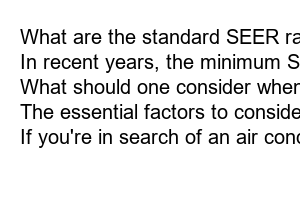에어컨 평수 계산
Air conditioning has become an essential aspect of indoor comfort, especially during summers. With the scorching heatwaves, almost everyone relies on air conditioning systems to beat the heat. However, purchasing an air conditioner that suits your preferences can be a challenging task. One of the most crucial factors to consider when buying an air conditioner is its rating calculation. Keep reading to learn more!
What is an Air Conditioner Rating Calculation?
An air conditioner rating calculation is a measurement that evaluates an air conditioner’s energy efficiency. Manufacturers carry out these calculations to determine the air conditioner’s Seasonal Energy Efficiency Ratio (SEER). SEER measures the effectiveness of an air conditioner by its ability to produce cool air for an extended time while consuming less energy.
Steps to Calculate Air Conditioner Rating
1. Determine the BTUs: BTUs measure the cooling capacity of an air conditioner unit. A higher BTU rating indicates that the air conditioner can cool a room faster and effectively.
2. Evaluate the airflow: The amount of airflow generated by an air conditioner can make a big difference in the cooling experience. Therefore, it’s essential to consider the air conditioner’s airflow when calculating its rating.
3. Factor in the size of the room: The size of the room where the air conditioner will be installed determines the cooling capacity required. Therefore, manufacturers consider the room size when determining an air conditioner’s rating.
4. Evaluate the ductwork: Effective and efficient ductwork ensures that an air conditioner cools a room effectively while consuming less energy. Therefore, manufacturers consider the air conditioner’s ductwork when evaluating its energy efficiency.
What are the benefits of high SEER ratings?
1. Saves Energy Bills: Air conditioners with higher SEER ratings consume less energy than those with low ratings, significantly reducing energy bills.
2. Better Environmental Conservation: Energy-efficient air conditioners reduce energy consumption, resulting in fewer carbon emissions, hence actively contributing to environmental conservation.
What factors determine an air conditioner’s SEER rating?
The air conditioner’s compressor, refrigerant, and ductwork determine an air conditioner’s SEER rating. A high-quality compressor, refrigerant, and efficient ductwork lead to higher SEER ratings.
Which air conditioner’s SEER rating is ideal?
Air Conditioners with SEER ratings above 16 are considered high-efficiency systems. However, the best SEER rating is typically between 18-25 for optimal energy efficiency while providing the best comfort.
What are the standard SEER ratings for air conditioners?
In recent years, the minimum SEER rating for air conditioners is set at 14. However, the best SEER ratings available range from 18-30.
What should one consider when buying an air conditioner?
The essential factors to consider when buying an air conditioner include BTU ratings, SEER ratings, airflow, and the size of the room where the air conditioner will be installed.
If you’re in search of an air conditioner that’s both effective and energy-efficient, understanding its rating calculations is crucial. With this knowledge, you can purchase an air conditioner with a high SEER rating that will significantly save on energy costs and effectively cool your home.

